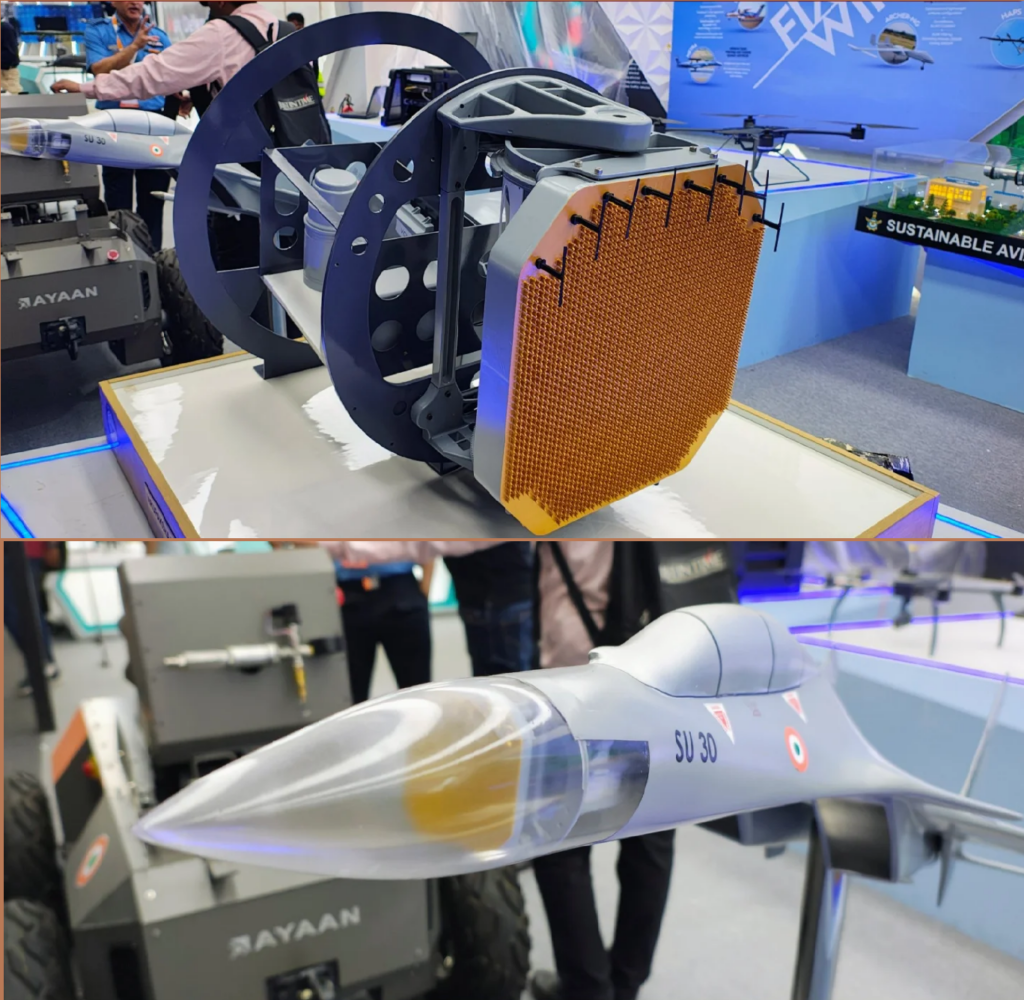
- The Virupaksha AESA radar ensures superior target tracking, threat detection, and enhanced battlefield performance in both air and ground operations.
- The Virupaksha AESA Radar can identify, monitor, and eliminate sophisticated aerial threats, including stealth aircraft, electronic warfare (EW) assaults, and low-RCS targets.
- Virupaksha Radar is an innovation for the future fighter with high-speed observation, high-quality functions governing fire, and network war integration.
- From a strategic perspective, Virupaksha Radar bolsters border defence, early warning systems, and precision strike capabilities, allowing fighter jets to function efficiently in high-threat environments.
At Aero India 2025, the Virupaksha AESA Radar, created by DRDO and BEL, was unveiled as India’s answer for upgrading the N011 Bars radar on the Su-30MKI. With around 2,400 GaN-based TR modules and a 950 mm antenna, it boasts a detection range of over 250 km, improving the aircraft’s tracking, targeting, and combat capabilities.
Progression in Comparison to Existing Radar Systems The Indian Air Force (IAF) currently uses both AESA and PESA radars. AESA radars utilize independent transmitter modules, allowing for quicker scans, enhanced resolution, and better anti-jamming capabilities compared to PESA, which depends on a single transmitter. AESA radars function in the 8-12 GHz X-band, delivering high-resolution images, whereas PESA radars operate in the 4-8 GHz C-band, which reduces their effectiveness in contemporary combat.
The Super Sukhoi Upgrade The Su-30MKI serves as a crucial component for the IAF, but its dependence on the outdated N011M Bars PESA radar limits its effectiveness against contemporary threats. The Virupaksha AESA radar, an essential element of the Super Sukhoi initiative, will improve situational awareness and enhance air-to-air and air-to-ground combat abilities while prolonging the aircraft’s operational lifespan by 30 years. Performance and Integration Thanks to GaN technology, the Virupaksha radar is anticipated to achieve a range of around 455 km. Its compact modular structure makes testing and maintenance easier, thereby enhancing reliability.
As the Su-30MKI undergoes this upgrade, India’s Rafale jets are already fitted with GaAs-based AESA radars, showcasing an increasing diversity in radar technology within India. Incorporation with ECS Cluster The Electronics and Communication Systems (ECS) cluster is essential for the development of electronic warfare (EW) systems, radars, electro-optical hardware, lasers, and directed energy weapons (DEW). This cluster includes key laboratories such as DARE, DEAL, DLRL, IRDE, LASTEC, and LRDE. These organizations play a role in significant defence initiatives, such as missiles, UAVs, early warning systems, air defence systems, main battle tanks, and coastal surveillance systems.
Seamlessly integrating with India’s existing EW systems, DEW, laser technologies, and communication systems, the Virupaksha AESA radar ensures superior target tracking, threat detection, and enhanced battlefield performance in both air and ground operations.
How the Key Components of Virupaksha AESA Radar Work Together
With its various elements working in unison for efficient target detection and tracking, the Virupaksha AESA Radar is a highly advanced system. The process begins with the T/R Modules (Transmitter/Receiver), which send out high-frequency radar waves toward a target and capture the signals that bounce back. The arrangement of these modules in an array facilitates simultaneous multi-beam transmission, resulting in a quicker scan. Then, the radar beams are electronically steered by the AESA Antenna without any mechanical movement, which facilitates high-speed scanning and multi-target tracking.
The Beamforming Network manages the phase and direction of beams to ensure precise targeting and minimal signal loss. The Radar Signal Processor eliminates noise and extracts crucial information such as the range, speed, altitude, and direction of detected objects after receiving the reflected signals. The Radar Signal Processor eliminates noise and extracts crucial information such as the range, speed, altitude, and direction of detected objects after receiving the reflected signals. The Synthetic Aperture Radar (SAR) is crucial for reconnaissance and surveillance, as it generates high-resolution images of terrain, moving objects, or enemy installations by interpreting reflections when high-resolution imaging is required.
Finally, all information that has been processed is forwarded to the cockpit display or command centre, which allows pilots and operators to examine the data in real time and take suitable actions. These items of equipment combine to create a highly efficient, precise, and jam-proof radar system—an essential component of modern aerial reconnaissance and combat.
Virupaksha AESA Radar: Combat Simulation, Counteractions & Integration with Fighter Aircraft
The Virupaksha AESA Radar is a cutting-edge radar system that can identify, monitor, and eliminate sophisticated aerial threats, including stealth aircraft, electronic warfare (EW) assaults, and low-RCS (Radar Cross Section) targets. Under simulated combat scenarios, it operates in Low Probability of Intercept (LPI) mode, employing beamforming, frequency agility, and Doppler processing to identify even the most sophisticated stealth fighters like the F-35, J-20, and Su-57.
Defeating Stealth & Electronic Warfare Threats
The Virupaksha AESA Radar overcomes the increasing challenge of stealth technology by detecting radial velocity changes, passive emissions, and infrared signatures. Their GaNP-based high-frequency T/R modules enhance the detection range, and multi-static radar networking is integrated with AWACS, satellites, and ground sensors to track low-observable targets from various angles.
The radar employs adaptive noise cancellation, frequency hopping, and DRFM (Digital Radio Frequency Memory) jamming resistance to withstand the effects of electronic jamming. It works alongside Electronic Combat Systems (ECS) to deliver signal processing, deception countermeasures, and electronic protection, ensuring continuous situational awareness even in high-threat environments.
Significance in Fighter Jet Integration
Virupaksha Radar is an innovation for the future fighter with high speed observation, high-quality functions governing fire, and network war integration. It is useful for next generation fighter aircraft like TEJAS MK2, AMCA and SU-30MKI and has several tactical benefits. Beyond the visible horizon (BVR), it gives precise goal observation of long-term air missiles.
- The flexibility of multi-roll missions: air atmosphere, air battery and marine intelligence can be applied to change the different combat missions.
- Network Data Network and Sensory Network: In coordination with IRST, Electronic Military Apartments and Battlefield Network enhance the situation awareness.
- Sustainability of the war: To maintain efficient performance even with intense jamming in coordination with ECS and counter meter.
Conclusion
With the Virupaksha AESA Radar, modern aerial warfare is transformed, as it improves detection, tracking, and resistance to electronic warfare. It can ensure air superiority and national security by countering stealth threats and electronic jamming. From a strategic perspective, it bolsters border defence, early warning systems, and precision strike capabilities, allowing fighter jets to function efficiently in high-threat environments. Its integration of network-centric warfare improves real-time situational awareness, aiding joint force and multi-domain operations. The Virupaksha AESA Radar guarantees that contemporary fighter aircraft retain a technological advantage over enemies, as stealth aircraft and EW threats are developing. Its introduction will be vital for securing airspace, bolstering defence strategies, and ensuring dominance in future conflicts.
References:
- https://www.drdo.gov.in/drdo/labs-establishment/technologies/electronics-radar-development-establishment-lrde
- https://www.drdo.gov.in/drdo/technology-cluster/about-us/electronics-and-communications
- https://www.defensemirror.com/news/38803#:~:text=India’s%20Defense%20Research%20and%20Development,ability%20to%20develop%20radar%20technology.
- https://idrw.org/drdo-unveils-virupaksha-aesa-radar-for-su-30mki-to-feature-massive-2400-trms/
- https://www.janes.com/osint-insights/defence-news/c4isr/aero-india-2025-drdo-showcases-4d-capable-virupaksha-radar
- https://sputniknews.in/20240805/indias-virupaksha-radar-to-revolutionise-su-3omki-fighter-jets-7961976.html
- https://www.drdo.gov.in/drdo/sites/default/files/drdo-news-documents/NPC15to17Feb2025.pdf
Piyush Anand is a Biotechnology Engineering student at Chandigarh University. His primary interest lies in International Affairs, Defence and Strategy. Views expressed are the author’s own.
